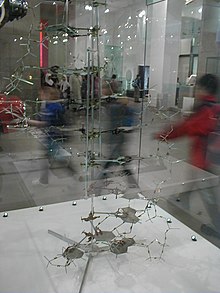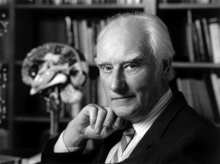Francis Crick
Francis Harry Compton Crick OM (born June 8, 1916 in Northampton , England , † July 28, 2004 in San Diego , USA ) was a British physicist and molecular biologist . In 1962 he received the Nobel Prize for Medicine together with James Watson and Maurice Wilkins for the discovery of the molecular structure of deoxyribonucleic acid (DNA).
Live and act


Crick attended Mill Hill School in London and graduated from University College London in 1937 with a degree in physics . In the meantime he worked for the British Navy and worked from 1940 to 1947 for the British Admiralty on radar as well as on magnetic and acoustic sea mines . From 1947 he studied biology and from 1949 devoted himself unsuccessfully to his doctorate at the Medical Research Council ( MRC Unit , later MRC Laboratory of Molecular Biology ) headed by William Lawrence Bragg at the Cavendish Laboratory of Cambridge University . There he was engaged in the X-ray crystallographic examination of the hemoglobin molecule when the American biochemist James Watson joined him in 1951 and both set out to decipher the structure of DNA. On February 28, 1953, both had managed to create a three-dimensional model of the DNA double helix . This model, which they presented in the article Molecular Structure of Nucleic Acids: A Structure for Deoxyribose Nucleic Acid in the journal Nature on April 25, achieved world fame and is still valid today.
In 1953, Crick received his PhD from Caius College .
In 1955, Crick presented his adapter hypothesis , which states that a hitherto unknown structure brings the amino acids to their destination and links them correctly there (today we know that this is the tRNA as an adapter molecule, see translation (biology) ).
In 1958 he formulated the central dogma of molecular biology .
In 1959, Crick was visiting professor at Harvard University and visiting scholar at the Rockefeller Institute of Medicine (now Rockefeller University ) in New York. 1960/61 he was a fellow at Churchill College, Cambridge. In 1962 he became head of the molecular genetics department at the MRC Laboratory and was co-director with Sydney Brenner from 1963. At the same time he was from 1962 Non Resident Fellow of the Salk Institute in La Jolla and moved there entirely in 1975. He was JW Kieckhefer Distinguished Professor there from 1977 to 2004 and President 1994/95. He was also Professor of Biology, Chemistry, and Psychology at the University of California, San Diego . He died of colon cancer.
In 1962, Crick, Wilkins, and Watson received the Nobel Prize in Physiology or Medicine for their spatial model of DNA . In 1960 Crick received the Albert Lasker Award for Basic Medical Research , in 1961 the Prix Charles-Léopold Mayer , in 1962 a Gairdner Foundation International Award and in 1972 the Royal Medal of the Royal Society . In 1962 he was elected to the American Academy of Arts and Sciences , in 1969 a member of the Leopoldina and the National Academy of Sciences . The American Philosophical Society , of which he was a member since 1972, awarded him in 2001 with their Benjamin Franklin Medal . In 1978 he became a member of the Académie des Sciences in Paris.
Crick was known for having unconventional ideas in various fields. In the 1970s, Crick took up the panspermia hypothesis (directed panspermia). He later turned to neuroscience and the theory of consciousness.
In old age Crick tried a great challenge at the Salk Institute in La Jolla, California , the attempt to unravel the essence of the mind and to explain it through a comprehensive theory. In 1990 he postulated that the time was ripe to tackle the riddle of the human mind scientifically. The people, "their joys and sorrows, their memories, their goals, their sense of their own identity and free will - all of this is really just the behavior of a huge collection of nerve cells and associated molecules," he formulated in his 1994 published book "What the soul really is".
Watson, Wilkins, and Crick have later been criticized for violating the rules of good scientific practice , as their 1953 publication in Nature was based on X-ray crystallographic recordings and unpublished research by Rosalind Franklin at King's College , whose unpopular colleague Maurice Wilkins did it for Watson and Crick without copied their knowledge. At least at the end of their Nature publication, Watson and Crick thanked them in summary for the “contributions” by Franklin and Wilkins, without going into the details.
Crick had a positive attitude towards eugenics and expressed his views on it mainly in personal communication. He was of the opinion that in the long term society would be forced to think about a (genetic) improvement for the coming generations. In the present, however, he saw little prospect of this due to widespread religious reservations.
See also
- Francis Crick Institute , or The Crick for short, UK Center for Medical Research and Innovation (UKCMRI) until July 2011
literature
- James D. Watson : The Double Helix , Rowohlt TB, 1997, ISBN 3-499-60255-5
- Francis Crick: What the soul really is , Rowohlt TB, 1997, ISBN 3-499-60257-1 (English original: The astonishing hypothesis: the scientific search for the soul , Scribner 1995)
- Francis Crick: Of Molecules and Men , Prometheus Books, 2004 (first 1967)
- Francis Crick: What mad pursuit. A personal view of scientific discovery , Basic Books 1990
- Francis Crick: Life itself. Its origin and its nature , Simon and Schuster 1981
- Remembering Francis Crick , Salk Institute, ed. 2004
Web links
- Literature by and about Francis Crick in the catalog of the German National Library
- Letters to nature: Molecular structure of Nucleic Acids (original publication by Watson and Crick on DNA structure 1953; PDF; 198 kB)
- Profiles in Science: The Crick papers (English)
- Information from the Nobel Foundation on the 1962 award to Francis Crick
- Entry to crick; Francis Harry Compton (1916-2004) in the Archives of the Royal Society , London
- Denis Grady: A Revolution at 50; 50 Years Later, Rosalind Franklin's X-Ray Fuels Debate New York Times , February 25, 2003
- Member Post by Francis Crick at the German Academy of Sciences Leopoldina , accessed on 26 April 2020th
Individual evidence
- ^ A b Nicholas Wade: Francis Crick, Co-Discoverer of DNA, Dies at 88. In: The New York Times . July 30, 2004, accessed January 21, 2013 .
- ^ Hans-Jörg Rheinberger : Crick, Francis Harry Compton. In: Werner E. Gerabek , Bernhard D. Haage, Gundolf Keil , Wolfgang Wegner (eds.): Enzyklopädie Medizingeschichte. De Gruyter, Berlin / New York 2005, ISBN 3-11-015714-4 , p. 278.
- ↑ JD Watson, FHC Crick: Molecular Structure of Nucleic Acids: A Structure for Deoxyribose Nucleic Acid. In: Nature . Volume 171, pp. 737-738, April 25, 1953, doi: 10.1038 / 171737a0 .
- ^ Hans-Jörg Rheinberger: Crick. 2005, p. 278.
- ^ Norbert Paul: Francis Harry Compton Crick. In: Wolfgang U. Eckart , Christoph Gradmann (Hrsg.): Ärztelexikon. From antiquity to the present. 3. Edition. Springer Verlag, Heidelberg / Berlin / New York 2006, p. 88 f. Medical glossary 2006 , doi : 10.1007 / 978-3-540-29585-3 .
- ↑ eprint : Gerhard Fröhlich: Plagiarism and unethical authorship. (PDF (443 kB)) eprints.rclis.org, April 16, 2005, archived from the original on May 2, 2006 ; accessed on December 21, 2014 .
- ↑ Denis Grady: A Revolution at 50; 50 Years Later, Rosalind Franklin's X-Ray Fuels Debate New York Times , February 25, 2003
- ↑ Matthew Cobb, Sexism in science: did Watson and Crick really steal Rosalind Franklin's data? , The Guardian, June 23, 2015
- ^ Ridley, Matt (2006). Francis Crick: discoverer of the genetic code. Ashland, OH: Atlas Books. ISBN 0-06-082333-X .
| personal data | |
|---|---|
| SURNAME | Crick, Francis |
| ALTERNATIVE NAMES | Crick, Francis Harry Compton (full name) |
| BRIEF DESCRIPTION | British physicist and biochemist and co-discoverer of the molecular structure of deoxyribonucleic acid |
| DATE OF BIRTH | June 8, 1916 |
| PLACE OF BIRTH | Northampton , England |
| DATE OF DEATH | July 28, 2004 |
| Place of death | San Diego , USA |

